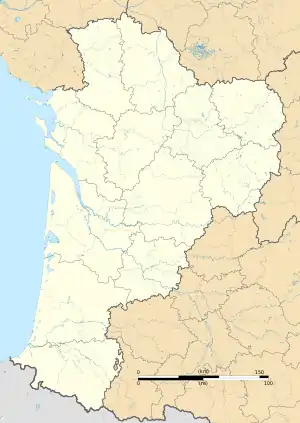Champsac | |
|---|---|
 Coat of arms | |
Location of Champsac | |
 Champsac  Champsac | |
| Coordinates: 45°42′13″N 0°57′27″E / 45.7036°N 0.95750°E | |
| Country | France |
| Region | Nouvelle-Aquitaine |
| Department | Haute-Vienne |
| Arrondissement | Rochechouart |
| Canton | Rochechouart |
| Government | |
| • Mayor (2020–2026) | Maryse Parverie[1] |
| Area 1 | 23.94 km2 (9.24 sq mi) |
| Population | 673 |
| • Density | 28/km2 (73/sq mi) |
| Time zone | UTC+01:00 (CET) |
| • Summer (DST) | UTC+02:00 (CEST) |
| INSEE/Postal code | 87036 /87230 |
| Elevation | 267–399 m (876–1,309 ft) |
| 1 French Land Register data, which excludes lakes, ponds, glaciers > 1 km2 (0.386 sq mi or 247 acres) and river estuaries. | |
Champsac (French pronunciation: [ʃɑ̃sak]; Occitan: Chamçac) is a commune in the Haute-Vienne department in the Nouvelle-Aquitaine region in western France, sitting near to both the Dordogne and Charente borders.
Inhabitants are known as Champsacois.
The village is situated within the Dordogne-Limousin National Park. Amenities within Champsac include a butcher, a baker, a hairdresser, a church, a wine merchant, and a bar/hotel/restaurant and tabac named 'Le Champsac'.
It is also very near to other amenities such as supermarkets, châteaux, lakes, cycle paths, fishing spots, etc., and sits approximately 30 minutes south-west of Limoges – Bellegarde Airport. The historic city of Limoges and towns/villages such as Rochechouart, Oradour-sur-Glane, Saint-Junien and Châlus are also close by.
The joint Aquitaine-Limousin-Poitou-Charentes, in which Champsac will sit, is a future Region of Southwestern France, created by the territorial reform of French Regions in 2014 by merger of Aquitaine, Limousin, and Poitou-Charentes. It will cover 84,061 square kilometers (32,456 square miles) - or 1/8 of the country - and will have 5,808,594 inhabitants. The new region will take effect after the regional elections of December 2015, on 1 January 2016.
See also
References
- ↑ "Répertoire national des élus: les maires". data.gouv.fr, Plateforme ouverte des données publiques françaises (in French). 2 December 2020.
- ↑ "Populations légales 2021". The National Institute of Statistics and Economic Studies. 28 December 2023.